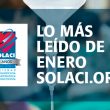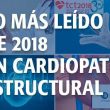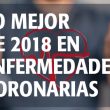1- What to Do with Blood Pressure Levels Between 130/80 and 139/89 mmHg The decision to be made with a treatment-free patient with systolic blood pressure over 160 mmHg or diastolic blood pressure over 100 mmHg is an easy one. All guidelines agree: treatment should be started immediately alongside lifestyle changes. Read more 2-<a href="https://solaci.org/en/2019/04/22/the-most-read-articles-of-march-in-interventional-cardiology/" title="Read more" >...</a>
The 10 Most Read Articles of January
1- These Were the Most Relevant Article of 2018 in the Field of Coronary Diseases Read the best articles on coronary heart disease from 2018 at solaci website. Read more 2- The 10 Commandments of ESC’s New STEMI Guidelines The authors have given an entertaining account of the most relevant points and differences between<a href="https://solaci.org/en/2019/02/15/the-10-most-read-articles-of-january/" title="Read more" >...</a>
The Most Relevant Articles of 2018 in Peripheral Vascular Disease
1- What’s New in the European Guidelines on Peripheral Arterial Disease Since the last version of the European guidelines on the diagnosis and treatment of peripheral arterial disease in 2011, there have been many trials and registries that warrant guideline adjustments in many aspects. The first novelty is the teamwork that gave way to these<a href="https://solaci.org/en/2019/02/04/the-most-relevant-articles-of-2018-in-peripheral-vascular-disease/" title="Read more" >...</a>
The Ten Commandments for the Fourth Universal Definition of Infarction
The Fourth Universal Definition of Myocardial Infarction is a document developed jointly by the European Society of Cardiology (ESC), the American College of Cardiology (ACC), the American Heart Association (AHA), and the World Heart Federation (WHF). The Fourth Definition was necessary for multiple reasons, including increasingly higher troponin sensitivity. While troponin obviously does not<a href="https://solaci.org/en/2019/01/30/the-ten-commandments-for-the-fourth-universal-definition-of-infarction/" title="Read more" >...</a>
Outcomes of Contemporary DES in Patients with Diabetes: Do They Render Freedom Obsolete?
Despite our high hopes for new-generation drug-eluting stents (DES), patients with diabetes still have a different prognosis, both clinical and angiographic, compared with non-diabetic patients. Authors sought to investigate the impact of diabetes on patients who underwent drug-eluting stent implantation in the BIONICS (BioNIR Ridaforolimus Eluting Coronary Stent System in Coronary Stenosis) trial. This<a href="https://solaci.org/en/2019/01/28/outcomes-of-contemporary-des-in-patients-with-diabetes-do-they-render-freedom-obsolete/" title="Read more" >...</a>
The Most Important Articles of 2018 in Structural Heart Diseases
1- ESC 2018 | MITRA FR: Testing MitraClip for Secondary Mitral Regurgitation In secondary mitral regurgitation, mitral-valve leaflets and chordae are structurally normal and mitral regurgitation results from alterations in left ventricular geometry and function. Read more 2- TCT 2018 | COAPT: MitraClip in Patients with Secondary Mitral Regurgitation The prognosis of patients with<a href="https://solaci.org/en/2019/01/18/the-most-important-articles-of-2018-in-structural-heart-diseases/" title="Read more" >...</a>
These Were the Most Relevant Article of 2018 in the Field of Coronary Diseases
1- The CULPRIT-SHOCK Study Is Finally Published in NEJM and It Is Bound to Change Guidelines During SOLACI’s coverage of the TCT 2017 Congress in Denver, Colorado, we already mentioned some of the outcomes of this study that has arrived to revolutionize clinical practice, given the differences between its results and those of the classic<a href="https://solaci.org/en/2019/01/11/these-were-the-most-relevant-article-of-2018-in-the-field-of-coronary-diseases/" title="Read more" >...</a>
Practical Management of Coronary Perforations
Coronary perforation has an incidence of 0.5% and it is associated with a 13-fold increase in in-hospital events and a 5-fold increase in 30-day mortality. This event is so catastrophic that its management has become indispensable knowledge to all interventional cardiologists. This accident is most frequently provoked by artery over-dilation caused by a balloon or<a href="https://solaci.org/en/2018/11/06/practical-management-of-coronary-perforations/" title="Read more" >...</a>
TAVR in Patients with Classical Low Flow, Low Gradient
Classical symptomatic low-flow, low-gradient (LFLG) severe aortic stenosis is associated with low survival rates at 3 years (<50%). However, in the medium term and with surgery, those rates improve (although mortality rates are 6%-30%, depending on the series). In patients without contractile reserve, surgical mortality is higher. Patient evolution in TAVR is still mostly unclear. <a href="https://solaci.org/en/2018/04/12/tavr-in-patients-with-classical-low-flow-low-gradient/" title="Read more" >...</a>
ACC 2018 | Risk of MI in Non-Cardiac Surgeries
One in five patients presenting perioperative MI during non-cardiac surgery should be readmitted within 30 days after surgery, and one in seven dies within the same period, according to the new study presented at ACC 2018 scientific sessions and simultaneously published in Circulation. These infarctions could be considered a iatrogenic complication, given the obvious lack of proper<a href="https://solaci.org/en/2018/04/09/acc-2018-risk-of-mi-in-non-cardiac-surgeries/" title="Read more" >...</a>









